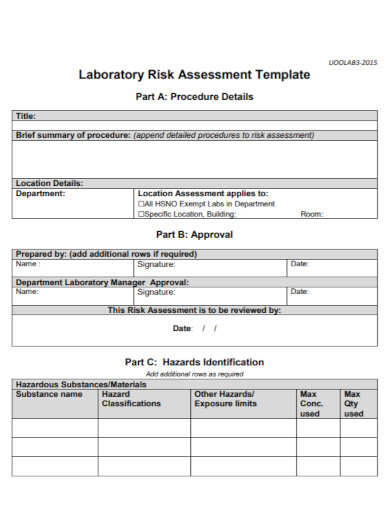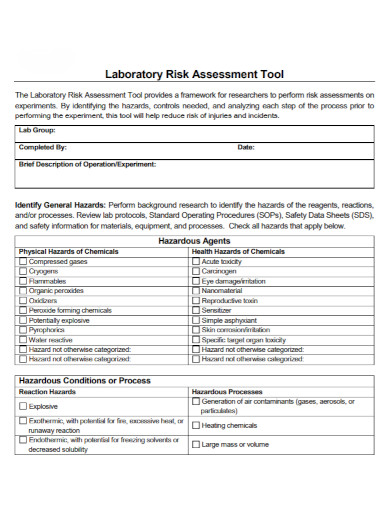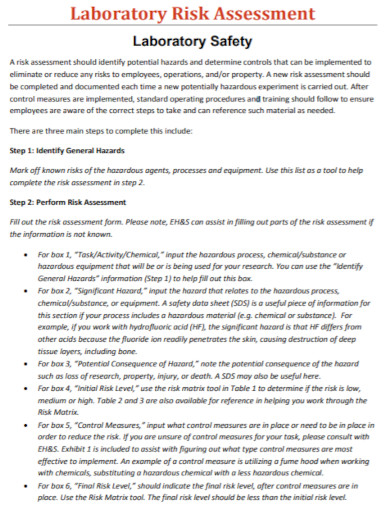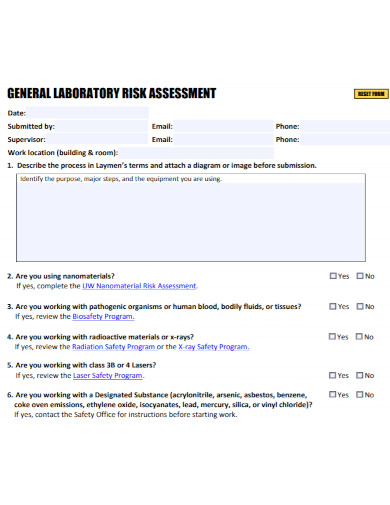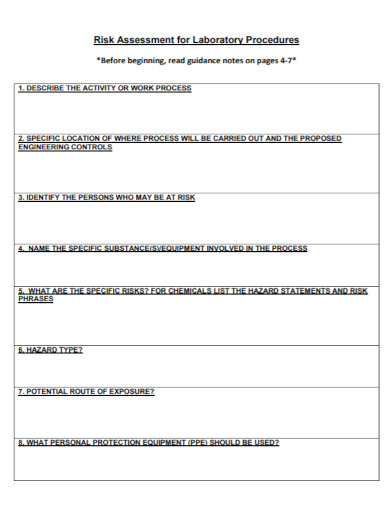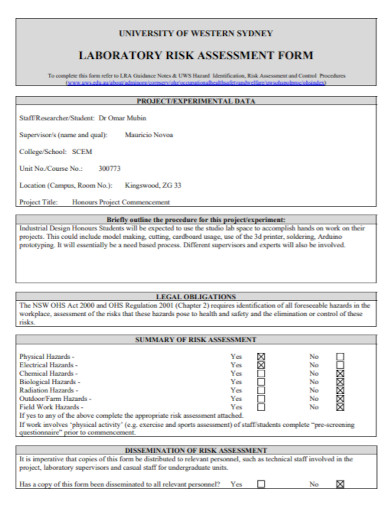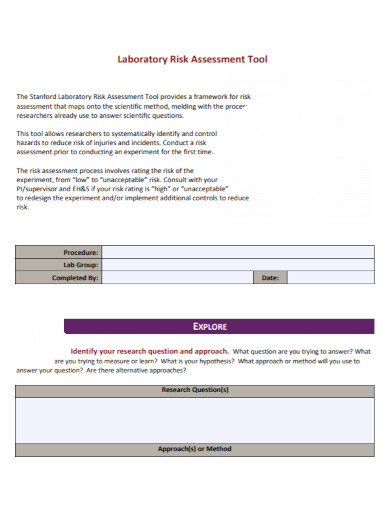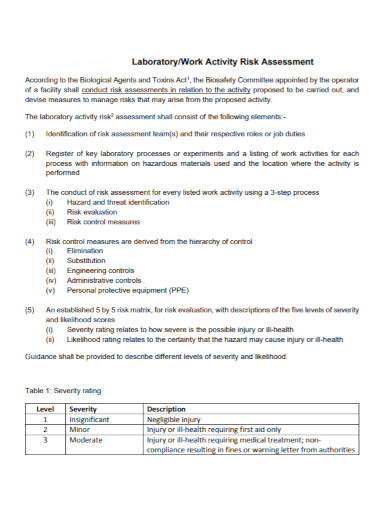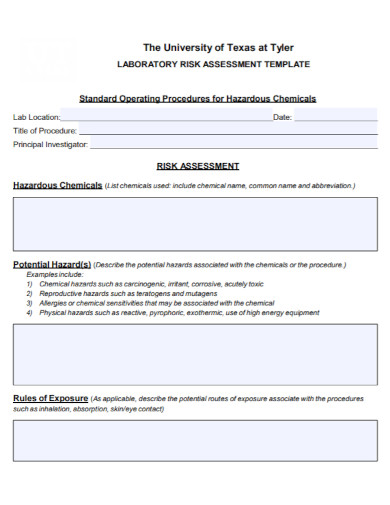10+ Laboratory Risk Assessment Examples to Download
Risks and hazards can happen just about anywhere and at any given time. There are also some casualties that often befall on people who do not expect anything to happen at any given moment. From dangers that range in laboratories, to classroom problems. Risks and hazards often take a toll for people who may have to deal with them almost on a daily basis. But what if there was a way to know before it happens? Would you have done it to lessen the risk that may involve the people who may have to endure them? If you answered yes to that question, let me show you 10+ laboratory risk assessments. Check them out below.
10+ Laboratory Risk Assessment Examples
1. Laboratory School Risk Assessment Template
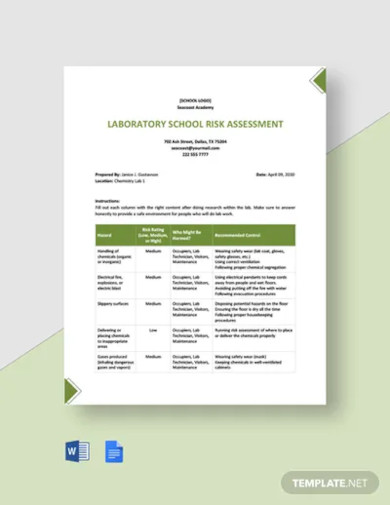
2. Laboratory Risk Assessment Template
3. Laboratory Work Risk Assessment
4. Standard Laboratory Risk Assessment
5. Laboratory Safety Risk Assessment
6. General Laboratory Risk Assessment
7. Risk Assessment for Laboratory
8. Laboratory Risk Assessment Form
9. Formal Laboratory Risk Assessment
10. Laboratory Activity Risk Assessment
11. University Laboratory Risk Assessment
Definition of Laboratory
A laboratory is a building or a room usually found in schools and universities. This room has most if not all the scientific equipment for doing scientific experiments. These scientific experiments are either for educational purposes or for medical purposes. This is also the place where you would find chemicals and other equipment that may be harmful if not handled properly. A place where people do scientific experiments.
Definition of Risk Assessment
A risk assessment from the term itself, is a type of assessment that identifies and analyzes risks. By doing this, it gathers information, analyzes data and gives an evaluation of how severe the risk may be. It also answers questions like who may be affected by the hazards and risks. As well as how to avoid or lessen the problem. This type of examination also finds solutions and actions that can be done to lessen or to eliminate the problem altogether. These assessments are mostly done by those who are familiar with the problem, but anyone can do these assessments. They do involve gathering a lot of data and evidence to prove the incident is the problem.
Importance of Laboratory Risk Assessment
The importance of doing a laboratory risk assessment, is to be able to predict or to picture out the outcome of something. It is also important to conduct assessments whenever a new experiment is made. This is to see that everyone present is safe and are less likely to be at risk of anything. In addition to that, it is also good to consider the health hazards that go with experiments. Ask yourself the question, how does this affect the people inside the laboratory. When you are able to find the answer to the assessment question, you are now able to gather enough data to analyze and make the evaluation.
Purpose of Laboratory Risk Assessment
The purpose of doing the laboratory risk assessment is to do research that can identify and control the issue. To be able to reduce the risks and casualties that go with it. By doing the assessment, you are making the level of risk from severe to low as possible. In addition to that, it also improves the workplace safety and the health of the people who work there. However, for this to happen, you must do a laboratory risk assessment to reduce the issue and to improve the place.
Tools for Laboratory Risk Assessment
When doing the laboratory risk assessment, there are tools you must use to complete it. The list below are merely some of the tools you can use, or the ones that are commonly used. You can also download the examples below for more. The tools are just a guide to examples for the laboratory risk assessment. Check them out now.
- Questionnaire
- Tick the box
- Checklist
- Essay
- Rubrics
- Fill Out form
Tips for Writing a Laboratory Risk Assessment
Moving on to tips for writing a laboratory risk assessment. Consider the following as a guide or like a road map for writing or doing the laboratory risk assessment. This is merely a suggestion and adds up learning lessons for writing. How you do your assessment will always depend on you. Now to the tips:
- Gather enough data to support your claims – When doing the assessment, the first thing you have to remember is to gather data. Gather enough data to support your claims and assessment. The reason for this is because you need evidence to prove that making the risk assessment is necessary.
- Start assessing the situation – As soon as you have enough evidence, start to assess the situation. You may also ask yourself who are the people who may be affected by the risk. In addition to that, you can also look at the picture by examining the place. Once you have a clearer picture of the risks and hazards that may happen, begin with conducting an experiment.
- Do an experiment for the assessment – To understand the risks that may befall on the situation, do an experiment.
- Evaluate your experiment and give the final assessment – Once you have done the full experiment, it is time to give out your final assessment or output.
- Record the results – Record the results for future experiments and for future reference. You may have the same problems, and rather than having to start over, your result may be used to compare a new assessment evaluation.
FAQs
Why is a laboratory risk assessment needed?
The reason why a laboratory risk assessment is needed is because it is used to assess how safe the environment for working is. It is also important to begin the assessment to check any other risks that may complicate the working environment. To be able to avoid this from happening, a risk assessment should be carried out.
How are the laboratory risk assessment results useful?
They are used as reference if another person chooses to do the same laboratory risk assessment. In addition to that, it is also used as something to be compared to when the need arises. The results are official and can be used to analyze the working situation.
Who are the people responsible for doing the laboratory risk assessment?
The people who are usually responsible for doing these types of assessments are those who are experts in the laboratory or chemical fields. A person who may not be an expert on that field, may also be able to do so but they must be careful.
Can the results be used for other purposes besides the assessment?
The results are mostly used to be compared to the assessment of another, but is rarely used for something that is not part of the assessment. Unless it is for educational purposes.
As they say, risks and hazards can be found just about anywhere, and even if we are careful to avoid them, there will always be that moment that we could not. But to avoid this from ever happening to any of us, a risk assessment is what should be done. To assess the situation and to find a way to eliminate the problem to make a better and safer working environment.


![10+ Laboratory Risk Assessment Examples [ School, University, Organizational ]](https://images.examples.com/wp-content/uploads/2021/07/10-Laboratory-Risk-Assessment-Examples-School-University-Organizational-.jpg)
